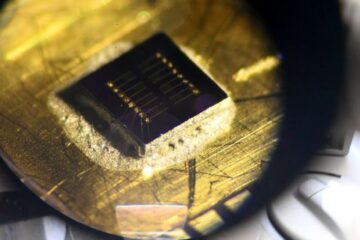Multimode Magnetic Field and Position Sensor from Oxford University

Researchers at Oxford University’s Physics Department have developed an extraordinarily versatile proximity sensor for the detection of objects, composed of ferrous and non-ferrous metals, ceramics, glasses and plastics. This new device could be used as a position or speed sensor in automotive suspension, gearbox and engine management systems, amongst many other uses.
Researchers had identified the need for a relatively simple, but highly versatile proximity sensor to detect the motion of a wide variety of metals and non-metals. Existing proximity sensors tended to rely on magnetic induction, reluctance or Hall effect devices for their performance characteristics, which in automotive ignition sensors can lead to poor slow running performance.
The Oxford invention consists of an electronic oscillator circuit, an antenna, and a discrete sensor element, all of which could be encapsulated into a single compact unit. The sensor is able to detect any relative movement between the object to be sensed and the sensor by detecting the perturbation of the electromagnetic field generated by the antenna. The sensor is highly versatile and can simultaneously detect changes in the both the electric or magnetic properties of the target object. The sensor itself requires no adjustment to change modes and generates a signal regardless of which parameter of the target object is changing. Tests have shown that a wide range of materials can be detected, ranging from ferromagnets, non-ferromagnets and non-ferrous metals, to ceramics and plastics.
A prototype of the sensor, which has already been tested as an ignition-timing sensor on an internal combustion engine, offers a high sensitivity, high output unit. The new sensor is also capable of detecting rotating magnets, ferrous wheels and brake discs, non-magnetic metal-toothed wheels, and even plastic gearwheels. The shape of the output signal from the sensor device is square, well-defined, and speed independent, unlike the variable reluctance sensor it would replace. The sensor element can tolerate temperatures in excess of 1000 oC for long periods and has an excellent signal to noise ratio. In mass production it would be cheap to produce and compact in size.
Other potential applications for the sensor, which is the subject of a patent application from Isis Innovation, Oxford University’s technology transfer company, include detection of changes in the flow of inhomogeneous liquids, such as blood/saline, water-in-oil or oil-in-water mixtures. Companies interested in exploiting this technology in any number of applications are welcome to contact Isis Innovation.
Media Contact
More Information:
http://www.isis-innovation.com/licensing/818.htmlAll latest news from the category: Process Engineering
This special field revolves around processes for modifying material properties (milling, cooling), composition (filtration, distillation) and type (oxidation, hydration).
Valuable information is available on a broad range of technologies including material separation, laser processes, measuring techniques and robot engineering in addition to testing methods and coating and materials analysis processes.
Newest articles

Sea slugs inspire highly stretchable biomedical sensor
USC Viterbi School of Engineering researcher Hangbo Zhao presents findings on highly stretchable and customizable microneedles for application in fields including neuroscience, tissue engineering, and wearable bioelectronics. The revolution in…

Twisting and binding matter waves with photons in a cavity
Precisely measuring the energy states of individual atoms has been a historical challenge for physicists due to atomic recoil. When an atom interacts with a photon, the atom “recoils” in…

Nanotubes, nanoparticles, and antibodies detect tiny amounts of fentanyl
New sensor is six orders of magnitude more sensitive than the next best thing. A research team at Pitt led by Alexander Star, a chemistry professor in the Kenneth P. Dietrich…





















